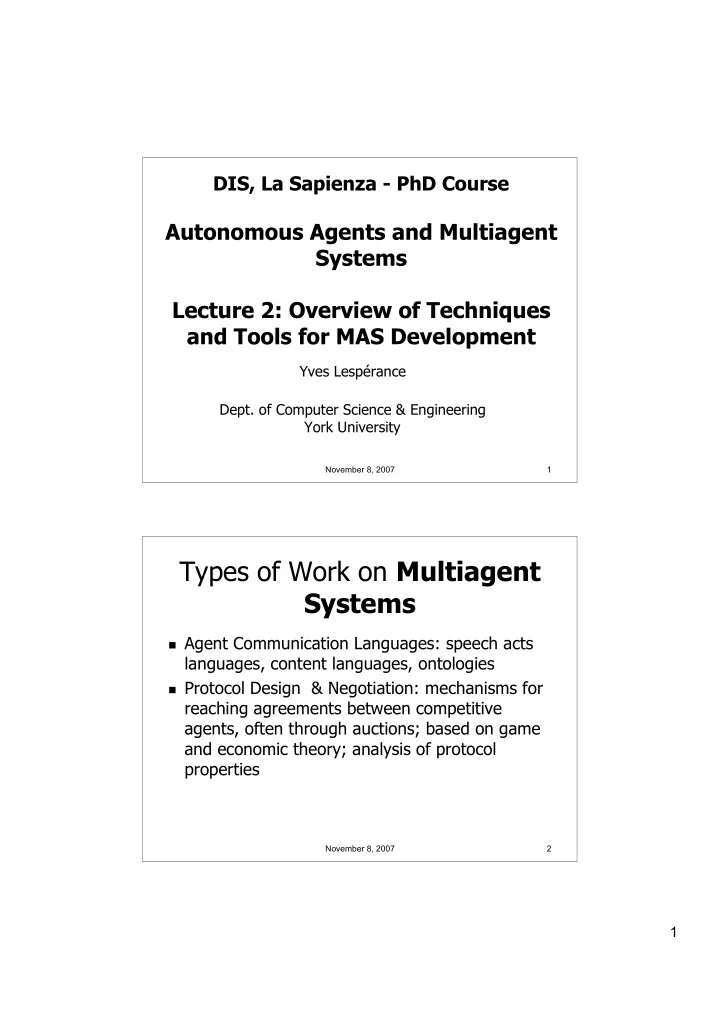

DIS, La Sapienza - PhD Course Autonomous Agents and Multiagent Systems Lecture 2: Overview of Techniques and Tools for MAS Development Yves Lespérance Dept. of Computer Science & Engineering York University November 8, 2007 1 Types of Work on Multiagent Systems Agent Communication Languages: speech acts languages, content languages, ontologies Protocol Design & Negotiation: mechanisms for reaching agreements between competitive agents, often through auctions; based on game and economic theory; analysis of protocol properties November 8, 2007 2 1
Types of Work on Multiagent Systems Task Allocation & Coordination: mechanisms for allocating tasks & sharing results, multiagent planning, ensuring that team members stay coordinated Multiagent Platforms/Infrastructures: languages and tools for programming MAS, providing basic services such as networking, yellow pages, etc.; e.g. SRI's Open Agent Architecture (OAA), Telecom Italia's Java Agent Development Environment (JADE), which is FIPA compliant November 8, 2007 3 FIPA Standards Foundations for Intelligent Physical Agents (FIPA) defined standards for MAS since 96, now an IEEE committee Several categories of standards: abstract architecture, agent management, agent communication, message transport, and applications November 8, 2007 4 2
FIPA Agent Management Reference Model •Agent Management System controls access & maintains directory of agents •Directory Facilitator provide yellow pages service •Message Transport System supports message transmission within & outside platform November 8, 2007 5 Speech Act Theory Human (agent) communication is a form of action Speech act theory tries to model this Searle’s classes of speech acts: Representatives, e.g. inform Directives, e.g. request Commissives, e.g. promise Expressives, e.g. thanking Declaratives, e.g. declare married November 8, 2007 6 3
Speech Act Theory Some speech acts are denoted by a performative verb, e.g. inform, request, etc. Some speech acts are indirect, e.g. “Can you close the window?” “I am cold” Many formalizations, e.g. [Cohen & Levesque 90b] November 8, 2007 7 DARPA Knowledge Sharing Effort (KSE) Developed models of communication between knowledge-based systems Separate content and “envelope” of message Envelope understandable even if content is not Proposed Knowledge Interchange Format (KIF) as content language, essentially FOL with predefined types & definitions in a Lisp syntax Knowledge Query and Manipulation Language (KQML) for envelope layer November 8, 2007 8 4
KQML E.g. KQML message (ask-one :content (PRICE IBM ?price) :receiver stock-server :language LPROLOG :ontology NYSE-TICKS) Message labeled with performative/speech act Other parameters :sender, :receiver, :content, :ontology, :reply-with, etc. November 8, 2007 9 KQML Large set of performatives, e.g. advertize, broker-one, stream- all, subscribe But no commissives Semantics specified late November 8, 2007 10 5
FIPA Agent Communication Language (ACL) Message structure similar to KQML Smaller set of performatives Semantics defined in Semantic Language (SL), a version of Cohen & Levesque’s logic developed by Sadek E.g. inform, request, query-if, call-for-proposal See FIPA Communicative Act Library Specification http://www.fipa.org/specs/fipa00037/SC00037J.pdf SL and some subsets are also content languages November 8, 2007 11 Interaction Protocols Specify “conversation types”, what kind of message is allowed under what conditions See e.g. FIPA request, query, & contract net protocol specs at http://www.fipa.org/repository/standardspecs.html November 8, 2007 12 6
Contract Net Protocol [Smith 77] Auction-like mechanism for task sharing/delegation Involves initiator/manager & participants/ possible bidders Stages: Task announcement/call for bids 1. Bidding by participants 2. Awarding of contract by initiator 3. (Follow up) 4. November 8, 2007 13 An MAS Platform: OAA Open Agent Architecture (OAA) is a platform for building MAS developed at SRI Evolved from blackboard systems from distributed AI, where entities (often rule-based) exchange information by putting it on the blackboard OAA provides facilitator agent(s) that act as a matchmaker Agents tell facilitator about their capabilities, i.e. declare “solvables” November 8, 2007 14 7
OAA Queries/requests (OAAsolve) are routed by the facilitator to an agent that can fulfill them Agents communicate in Interagent Communication Language (ICL) ICL is somewhat speech acts-based, with Prolog- style syntax OAA provides libraries for implementing agents in Java, various Prologs, etc. that support communication with facilitator November 8, 2007 15 OAA Good for rapid prototyping & integrating components implemented in different programming languages Facilitator can be a bottleneck Suitable for MAS with limited number of agents & message traffic November 8, 2007 16 8
Another MAS Platform: JADE Java Agent Development Environment (JADE) platform, developed at Telecom Italia Labs FIPA-compliant Java-based (library) Peer-to-peer communication model November 8, 2007 17 JADE Tries to keep communication & concurrency overhead low Agents running on given host implemented in single thread in single Java VM & message passed as objects using Java events (no serialization or conversion to String) Can have multiple agents containers running on several hosts, with message passing done using Java RMI (with serialization) November 8, 2007 18 9
JADE Supports communication with other FIPA- compliant platforms using CORBA IIOP (with String conversion) Agents don’t need to know how communication is implemented Elements of FIPA agent management reference model provided (AMS, DF, etc.) November 8, 2007 19 JADE Behavior Hierarchy • Can be used to specify agent behavior • Basic/lightweight concurrency support: round-robin scheduling over behaviors that must relinquish control • Predefined behaviors include sending/ receiving FIPA messages, playing roles in protocols such as contract net November 8, 2007 20 10
JADE Provides some MAS monitoring facilities with GUI Supports use of Java Expert System Shell (JESS) for implementing rule-based agents Jadex is a BDI agent programming framework developed on top of JADE by University of Hamburg Semantics AddOn supports semantic processing of msgs, inference, behavior spec November 8, 2007 21 11
Recommend
More recommend